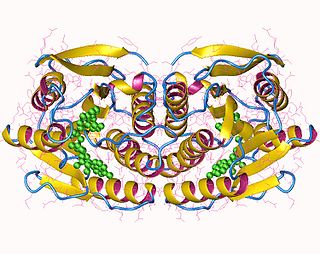| NAD(P)H dehydrogenase (quinone) | |||||||||
|---|---|---|---|---|---|---|---|---|---|
 NAD(P)H dehydrogenase (quinone) tetramer, Brucella abortus | |||||||||
| Identifiers | |||||||||
| EC no. | 1.6.5.2 | ||||||||
| CAS no. | 9032-20-6 | ||||||||
| Databases | |||||||||
| IntEnz | IntEnz view | ||||||||
| BRENDA | BRENDA entry | ||||||||
| ExPASy | NiceZyme view | ||||||||
| KEGG | KEGG entry | ||||||||
| MetaCyc | metabolic pathway | ||||||||
| PRIAM | profile | ||||||||
| PDB structures | RCSB PDB PDBe PDBsum | ||||||||
| Gene Ontology | AmiGO / QuickGO | ||||||||
| |||||||||
In enzymology, a NAD(P)H dehydrogenase (quinone) (EC 1.6.5.2) is an enzyme that catalyzes the chemical reaction
- NAD(P)H + H+ + a quinone NAD(P)+ + a hydroquinone
The 4 substrates of this enzyme are NADH, NADPH, H+, and quinone, whereas its 3 products are NAD+, NADP+, and hydroquinone.
This enzyme belongs to the family of oxidoreductases, specifically those acting on NADH or NADPH with a quinone or similar compound as acceptor. The systematic name of this enzyme class is NAD(P)H:quinone oxidoreductase. Other names in common use include menadione reductase, phylloquinone reductase, quinone reductase, dehydrogenase, reduced nicotinamide adenine dinucleotide (phosphate,, quinone), DT-diaphorase, flavoprotein NAD(P)H-quinone reductase, menadione oxidoreductase, NAD(P)H dehydrogenase, NAD(P)H menadione reductase, NAD(P)H-quinone dehydrogenase, NAD(P)H-quinone oxidoreductase, NAD(P)H: (quinone-acceptor)oxidoreductase, NAD(P)H: menadione oxidoreductase, NADH-menadione reductase, naphthoquinone reductase, p-benzoquinone reductase, reduced NAD(P)H dehydrogenase, viologen accepting pyridine nucleotide oxidoreductase, vitamin K reductase, diaphorase, reduced nicotinamide-adenine dinucleotide (phosphate) dehydrogenase, vitamin-K reductase, NAD(P)H2 dehydrogenase (quinone), NQO1, QR1, and NAD(P)H:(quinone-acceptor) oxidoreductase. This enzyme participates in biosynthesis of steroids. It employs one cofactor, FAD. At least one compound, Dicumarol is known to inhibit this enzyme.









